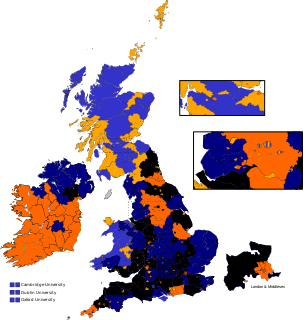Liverpool Exchange was a borough constituency within the city of Liverpool in England, centred on Liverpool Exchange railway station. It returned one Member of Parliament (MP) to the House of Commons of the Parliament of the United Kingdom, elected by the first past the post system.
Glasgow College was a parliamentary constituency in Glasgow. It returned one Member of Parliament (MP) to the House of Commons of the Parliament of the United Kingdom, elected by the plurality voting system.
Manchester South was one of six parliamentary constituencies created in 1885 by the division of the Parliamentary Borough of Manchester, England. It returned one Member of Parliament (MP) to the House of Commons of the Parliament of the United Kingdom, elected by the first-past-the-post voting system. The constituency was abolished in 1918.
Biggleswade was a county constituency in Bedfordshire which was represented in the House of Commons of the Parliament of the United Kingdom from 1885 until its abolition in 1918. It elected one Member of Parliament (MP) by the first-past-the-post voting system.
Birmingham Central is a former parliamentary constituency in the city of Birmingham, England. It returned one Member of Parliament (MP) to the House of Commons of the Parliament of the United Kingdom, elected by the first-past-the-post voting system.
Birmingham East was a parliamentary constituency in the city of Birmingham, England. It returned one Member of Parliament (MP) to the House of Commons of the Parliament of the United Kingdom, elected by the first-past-the-post voting system.

Islington East was a constituency which returned one Member of Parliament (MP) to the House of Commons of the Parliament of the United Kingdom from 1885, until it was abolished for the February 1974 general election.

Clapham was a borough constituency in South London which returned one Member of Parliament (MP) to the House of Commons of the UK Parliament. It was created in time for the 1885 general election then altered in periodic national boundary reviews, principally in 1918, and abolished before the February 1974 general election. In its early years the seat was officially named Battersea and Clapham Parliamentary Borough: No. 2—The Clapham Division.

Salford North was a parliamentary constituency in the City of Salford in Greater Manchester from 1885 until 1950. It returned one Member of Parliament (MP) to the House of Commons of the Parliament of the United Kingdom.

Salford South was a parliamentary constituency in the City of Salford in Greater Manchester from 1885 until 1950. It returned one Member of Parliament (MP) to the House of Commons of the Parliament of the United Kingdom.
Birmingham South was a parliamentary constituency in Birmingham which returned one Member of Parliament (MP) to the House of Commons of the Parliament of the United Kingdom from 1885 until it was abolished for the 1918 general election.

Brentford was a constituency named after the town of Brentford in Middlesex and was drawn to take in Hounslow, Norwood Green and Twickenham. It returned one Member of Parliament (MP) to the House of Commons of the UK Parliament. The constituency was created for the 1885 general election and abolished for that of 1918.
St Pancras East was a parliamentary constituency in the St Pancras district of North London. It returned one Member of Parliament (MP) to the House of Commons of the Parliament of the United Kingdom.

Strand was a parliamentary constituency in the Strand district of the City of Westminster. It returned one Member of Parliament (MP) to the House of Commons of the Parliament of the United Kingdom.

East Norfolk was a constituency in the county of Norfolk that returned two Members of Parliament to the House of Commons of the Parliament of the United Kingdom until 1868. A namesake was created in 1885 with representation of one member. That seat was abolished in 1950.
Birmingham Bordesley was a borough constituency in the city of Birmingham, which returned one Member of Parliament (MP) to the House of Commons of the Parliament of the United Kingdom. Elections were held using the first-past-the-post voting system.
Mid Northamptonshire was a county constituency in Northamptonshire, which returned one Member of Parliament (MP) to the House of Commons of the Parliament of the United Kingdom, elected by the first past the post system.
Otley was a parliamentary constituency between 1885 and 1918 centred on the town of Otley, then in the West Riding of Yorkshire and now in West Yorkshire. It returned one Member of Parliament (MP) to the House of Commons of the Parliament of the United Kingdom, elected by the first past the post system.

Newington West was a parliamentary constituency in the Newington area of South London. It returned one Member of Parliament (MP) to the House of Commons of the Parliament of the United Kingdom, elected by the first past the post system.
East Northamptonshire was a county constituency in Northamptonshire, which returned one Member of Parliament (MP) to the House of Commons of the Parliament of the United Kingdom.








